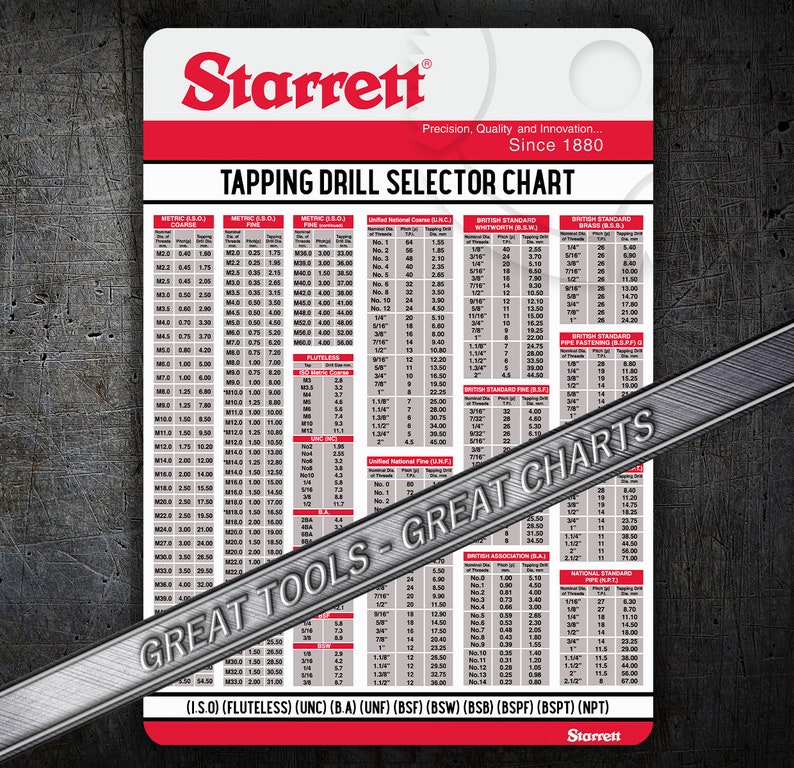

STARRETT WALL CHART / POSTER - NEW 25" x 39"*Plus 2 Free Starrett 3"X5" Pocket Charts Inch/Metric Tap & Drill wall chart covers decimal equivalents in 8ths, 16ths, 32nds and 64ths Decimal equivalents of Letter Size Drills (A-Z), Number Size Drills (1-80) and Metric Size Drills (0.1mm - 25mm) Drill Sizes for Standard Taps from #0-80 to 1 1/2-12 (approximately 75% thread) Pipe tap drill sizes from 1/8-27 to 4"-8 Metric Tap drill sizes from M1.6 x 0.35 to M39 x 3. Item: 300978106715 Starrett Wall Chart 25x39 Tap Drill Size, Decimal, Metric, Fraction Equivalents.
#Drill tap chart starrett pdf
Download Pipe Thread Drilled Hole Sizes PDF here.Location: Sterling Heights, Michigan, US, TAP SIZEĭrill sizes given are the ‘closest’ drill size. Tap Drill Chart (mm and inches)ĭrill sizes given are the ‘closest’ drill size. Both are available as a printable tap drill chart PDF as well. The first tap drill chart below is in mm and the next in inches.

This formula works for both metric and imperial units, and for all 60-degree threads (all ISO, DIN, UTS, UNC, UNS, and UNF bolts). Some prefer to use somewhat arbitrary but reliable formulas like: “Dtap = Nominal Diameter – Thread Pitch”. Or they can consult a tap drill chart like those found in the next section. Now engineers can sit down and manually calculate the right tap drill.
#Drill tap chart starrett iso
So for:-Īs per the ISO metric screw thread standard, the thread depth should be 0.614 x pitch, which is why a smaller pitch number also results in a lower thread depth value. The smaller the pitch value, the less deep the threading needs to go. To help you get the grasp of the fine-coarse difference, the M4 classification comprises of the:. Lower percentages such as “75% of the thread depth” are also widely used and considered safe. In our case, the correct tap drill would be the closest to 3.4 mm from below, and that is the 3.3 mm or 0.13-inch tap drill. A rule of thumb is that the right tap drill is around 85% for coarse threads and 90% for fine threads which feature a higher number of threads per axial distance. That would be a 3.7 mm drill bit, but using that drill would leave an inadequate margin for the creation of the appropriate thread depth. If that is the case, can we simply use the next smallest available drill size. The material will have to be cut and pushed out in order to create a thread in that hole.

So, if we wanted to drill a hole for our example bolt, we would need to use a drill that is smaller than 4 mm. Finally, 20 is the length of the bolt in mm, measured from the tip of the thread to the bottom of the head (with the exception of oval headed bolts). The second number (0.7) is the pitch which corresponds to the distance between two adjacent threads in millimeters. The “M” indicates the “metric diameter” of its thread (see tap drill chart below), which in our case is 4 mm. Bolts are classified by specification codes such as:. Having determined the bolt that we want to use in the specific case, we already have a technical specification for the thread which will host it. Thread Geometry And Drilling The HoleĪs is evident from the above, to create the thread we first need to drill a hole on the workpiece. If the taper needs to go first, the intermediate tap follows second and the thread is finished with the bottoming tap. This minimises the risk of damaging the drilled hole. The taper tap features a smooth diameter transition that allows for a less aggressive cutting action. The taper tap is only used in certain situations such as when the material is very hard or the hole is too small. However, the bottoming tap cannot start the threading on an uncut hole, so it can only take part in the cutting process as the second or third tap. So next comes the bottoming tap that has the capacity to do this.

Unfortunately, due to the shape it can’t create a thread all the way to the end of the hole. That is why it features a tapered bit, allowing the machinist to align it correctly. The intermediate, or plug tap, is used first to start cutting out material from a non-threaded hole. To create a thread properly, one would need a set of three taps that correspond to the same bit size namely the bottoming, the intermediate, and the taper tap. Therefore the tap drill chart is extremely important. As you would expect, taps come in all forms and sizes in order to accommodate standardised screw threads.


 0 kommentar(er)
0 kommentar(er)
